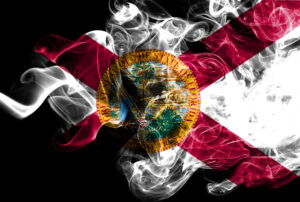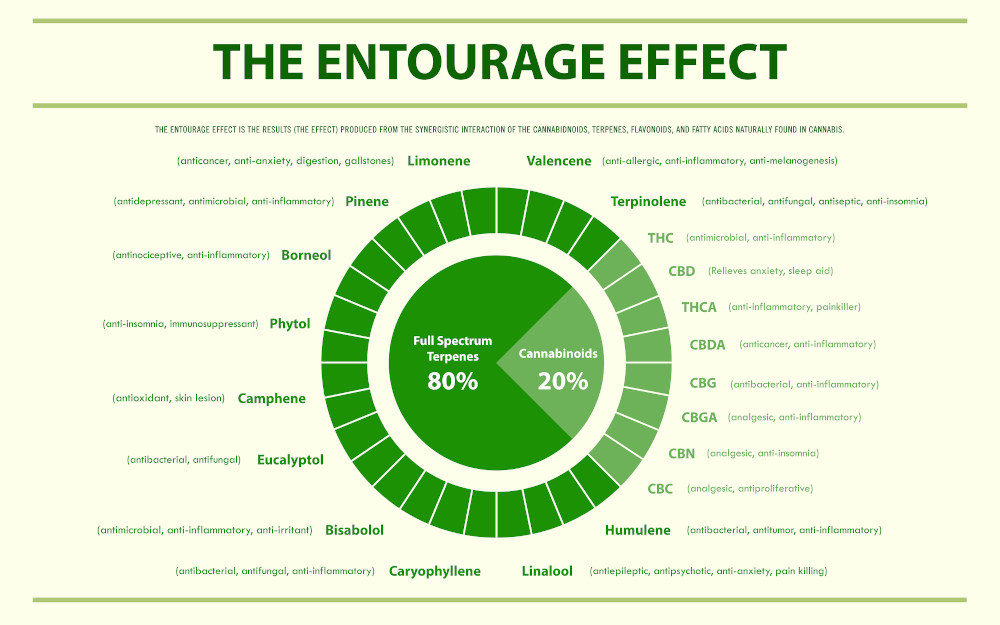
Cannabis Flower and the Curious Case of the Entourage Effect
En·tou·rage /ˌänto͝oˈräZH/ noun — A group of people attending or surrounding an important person. (eg. "an entourage of bodyguards")

Today we’re talking about the curious phenomenon known to marijuana aficionados as the “entourage effect”.
According to definition, an entourage is a group of people attending to an important person — such as a group of bodyguards. Another interpretation is a group of people that travel and work together to achieve a particular purpose.
Obviously, these are metaphors. So what are the similes in these metaphors?
The important person in this allegorical entourage is the overall effect that a particular strain of cannabis has on the human body — whether or not it makes you dozy or invigorates you, chills you out or makes you edgy, dulls your pain or heightens your senses, or any combination of a plenitude of potential effects.
The metaphorical group of people supporting our VIP (overall effect) consists of the various active compounds which are present in cannabis flowers (aka marijuana buds). These two families are large and diverse and their members number in the dozens.
But who exactly are the “characters” in this entourage, what are they doing here, what are their personalities, and what are their jobs in enhancing the overall impact.
The chief active compounds that are present in cannabis resins fall into two camps. Each family of compounds is unique in its structure and purpose. They are:
- The Cannabinoids
- The Terpenes
Meet the Cannabinoids

The most well-known family of compounds present in the resins of cannabis flowers are the Cannabinoids. The most famous and powerful of them all is a cannabinoid named Delta-9 Tetrahydrocannabinol.
Friends call him THC. This euphoria-inducing cannabinoid works in partnership with the second richest cannabinoid, Cannabidiol. Friends know her as CBD. Although CBD isn’t involved directly in the intoxicating personality of THC, she does have the ability to reign in his effects.
THC and CBD have a kind of yin-yang relationship. In terms of psychological sensations, THC works mainly in the brain by triggering changes in chemical and electrical activity of neurons. It does this by binding to receptors on the surface of brain cells known as cannabinoid receptors. Although these so-called CB1 receptors don’t have the affinity for CBD that they do for THC, CBD does interact with these receptors and tempers their receptiveness to THC. CBD also interacts with CB2 receptors found in organs throughout the human body and is known for its powerful anti-inflammatory, pain-reducing, seizure-taming, and anti-anxiety effects among others.
This is a good time to state that the human body also produces its own natural cannabinoid compounds. Technically, this family is known as the Endocannabinoids, while those produced in plants are known as the Phytocannabinoids. Your brain has a hard time telling members of these two families apart as Phytocannabinoids have an uncanny ability to impersonate their Endocannabinoid cousins. This ability to work with one of the body’s most powerful systems of signaling molecules and receptors — the endocannabinoid system — is what makes pot so effective.
Along with THC and CBD there are a multitude of other cannabinoids present in cannabis flowers such as cannabigerol (CBG), cannabinol (CBN), cannabichromene (CBC), and many others. Each of these has their own purpose in life. Some contribute to the intoxicating effects of cannabis, some add to the anti-inflammatory and pain-killing effects, some act to reduce involuntary muscle spasms and seizures, and so on. Although these lesser cannabinoids are generally produced in minuscule quantities, we can’t underestimate their influence on the overall effect. There is still much research to be done on the Cannabinoid family.
On a side note, while any strain of cannabis that produces more than 0.3 percent THC is recognized as marijuana, those strains which fall below that level are defined as hemp. While marijuana is infamous for its ability to make people high, hemp, although it can be a great source of CBD, couldn’t get a fly high, as they say.
Meet the Terpenes
The relative presence of these various compounds determines much of the overall effect of weed, but there’s another, even more, powerful family at work. As a family, the presence of the Terpenes in the entourage is far more modest. However, the Terpenes wield great power over the overall impact of a strain.
While the Cannabinoids are calculated as a percentage of the weight of the bud, the Terpenes are counted in parts-per-million. Cannabinoids can make up as much 25 percent of a powerful strain, while the Terpenes are far, far more scarce. But what this family lacks in numbers it makes up for in sheer power.
While Cannabinoids are known to be fairly calm — it takes turning up the heat to get them working — Terpenes are much more volatile. (In scientific terms that just means that they evaporate easily.) Terpenes are responsible for giving various strains of cannabis their distinct aromas and flavors. The human nose and nervous systems are extremely sensitive to these tiny molecules. Within one second of unboxing a good bud, it can be smelled clear across the room and produce a real physical effect on the recipient.
Plants have evolved the ability to produce terpenes over eons. Their purpose in life has been to attract pollinators and repel pests. In order to achieve their goal, these nano-scale molecules need to have very powerful effects on the physiology and mindset of living creatures.
Some of the more prominent members of the Terpene family include:
- Linalool – floral scent, used as a sleep aid, antipsychotic, anxiety reducer, antiseizure agent, pain reliever, and anti-inflammatory
- Myrcene – spicy scent, anti-tumor, anti-inflammatory, anti-spasmodic, sleep aid, pain reducer
- Pinene – pine scent, anti-asthmatic, anti-inflammatory, stimulant
- Limonene – citrus scent, antifungal, antidepressant, anxiety reducer, anti-tumor, immuno-stimulant
These are just a few of the members of the powerful Terpene family. There are dozens more.
Together, depending on their combination, although their numbers are minuscule compared to the Cannabinoids, this powerful family holds great sway over the overall effect of a particular strain.
Cannabis Flower - The Family Portrait
Although cannabis started out with humble beginnings it has been welcome by humans since the dawn of civilization. It was one of the earliest known plants to be cultivated by humans for its seeds and fibers. Over the eons, humans have bred various strains of cannabis for different purposes including not only medicinal but also functional and nutritional purposes.
One of the more interesting facts about marijuana is that it must be heated — either smoked or vaporized — to cause a buzz. However, it still has powerful medicinal properties in its raw state. In fact, the leaves, flowers, and seeds of the plant have been a good health-supporting food source for mammals for eons.
Today, now that we know the powerful effects of smoking marijuana, there are literally thousands of strains of the type of cannabis we fondly refer to as marijuana. And each strain, depending on the presence of individuals in these two families of compounds, produces its own overall effect.
Found in the sticky resins of cannabis flower clusters, these oils can be extracted and refined. A first pressing or extraction of the resins will leave behind the solid plant matter while maintaining the ratios of cannabinoids and terpenes found in the original bud. Consuming these derivatives has roughly the same effect as smoking or vaping the dried flower clusters — aka buds. The same goes for hashish, which is made up of only the most resinous parts of the flowers.
The more the oils are refined, the more the ratios of these compounds will change. While rosins, waxes, hash, oils, and so on tend to retain, for the most part, the personality of the original plant, the more refined the product, the more its effects will deviate from the effects of the original strain.
Taken to its limit, individual cannabinoids and terpenes can be distilled out of the mix and purified. These purified cannabinoids and terpenes each have a particular effect on the human body (though it varies from person to person). However, consuming individual cannabinoids or terpenes will not result produce an entourage effect. This because many of these members of the entourage in some measure affect how the other members behave. Without them, however, the behavior of each individual is more predictable.
So, dear reader, choose your strains wisely and you’ll enjoy refreshing relief. Choose unwisely, and you may end up couch-locked when you want to be active and creative, or amped up when you want to be chilled out. Talk your budtender. Tell them about your lifestyle and the effect you’re going for, and choose your entourage wisely.
© Copyright 2020 Newdelz LLC All Rights Reserved






